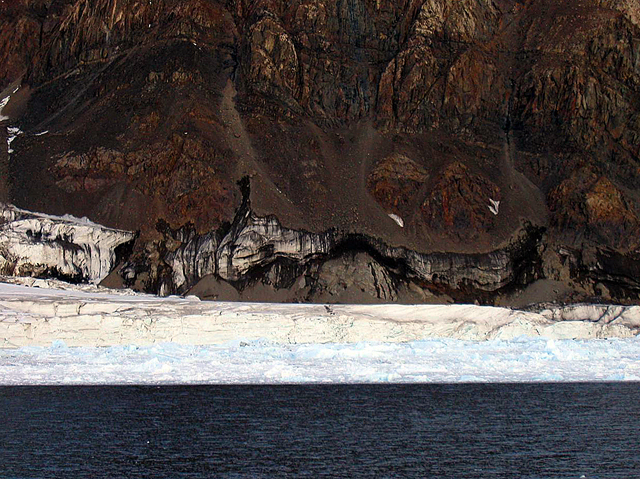|
Mixing it upLARISSA encourages cross fertilization between disciplinesPosted September 18, 2009
So what do ice cores have to do with free-floating algal blooms? What is the link between seafloor sediments and hard-charging glaciers? The LARISSA program How will the findings from one branch inform the work of the others? It’s a question the scientists themselves are still figuring out. “By studying the system all at once we’re going to find ways in which one research discipline feeds into another one,” said Ted Scambos For example, Scambos said the Crane Glacier fjord intrigues both the glaciologists and the marine geologist, Eugene Domack “Eugene sees a potential climate record in the sediment layers left by the lakes — and what I see is evidence that some of the recent speed-up of the glacier may be caused by yet another lake, still under the ice,” Scambos explained. As this lake drains, the glacier surface lowers, and becomes steeper, causing it to speed up. “So there’s a link between what the marine geology is doing and what the glaciology program hopes to measure right there,” Scambos said. Another connection involves the eventual analysis of an ice core that a team from The Ohio State University Biologist Maria Vernet 
Photo Credit: Wendy Kozlowski
Maria Vernet runs samples in the lab aboard the ARSV Laurence M. Gould.
“That is going to give us a long-term idea of phytoplankton production in the Larsen area,” said Vernet, with the Scripps Institution of Oceanography at UC San Diego The sediment record can also provide information on past productive events, Vernet explained, adding that Amy Leventer from Colgate University “We will then relate productivity in the past with ice shelf extent, and reconstruct the past based on what we learn on the cruise of present-day production and ice shelf dynamics,” Vernet said. Ellen Mosley-Thompson “I think the information we will provide will be informative for the other team members,” she said. “I’m also confident that once we’ve reconstructed the various chemical and physical profiles, there will be things that we’ll see in our record that we won’t be able to interpret independently. We will need the information, for example, coming from the sediment cores.” The cores from the seafloor mud provide their own paleoclimate record based on the types of sediments and rocks found. In addition, the sediments can provide clues as to what mechanisms might have been at work before the Larsen B Ice Shelf collapsed. What role might a subglacial lake have played in the instability of the ice shelf? How did the grounding line where the ice attached to bedrock erode? “These are all really important questions in terms of interpreting other Antarctic sequences that have been drilled,” noted Domack, referring to other sediment-drilling programs like the Cape Roberts Project and ANDRILL Noted Scambos, “It’s a great area to invest all of this effort into, and we’re really making maximum use of everything the Palmer can do,” he said. “We’re really living up to the interdisciplinary concept that [the National Science Foundation The LARISSA project is one of two large, integrated IPY projects — the other is studying the Pine Island Glacier region — that are funded by NSF’s Antarctic Integrated System Science (AISS) program NSF-funded research in this story: Eugene Domack, Hamilton College, Award No. 0732467 |



For USAP Participants |
For The Public |
For Researchers and EducatorsContact UsNational Science FoundationOffice of Polar Programs Geosciences Directorate 2415 Eisenhower Avenue, Suite W7100 Alexandria, VA 22314 Sign up for the NSF Office of Polar Programs newsletter and events. Feedback Form |



